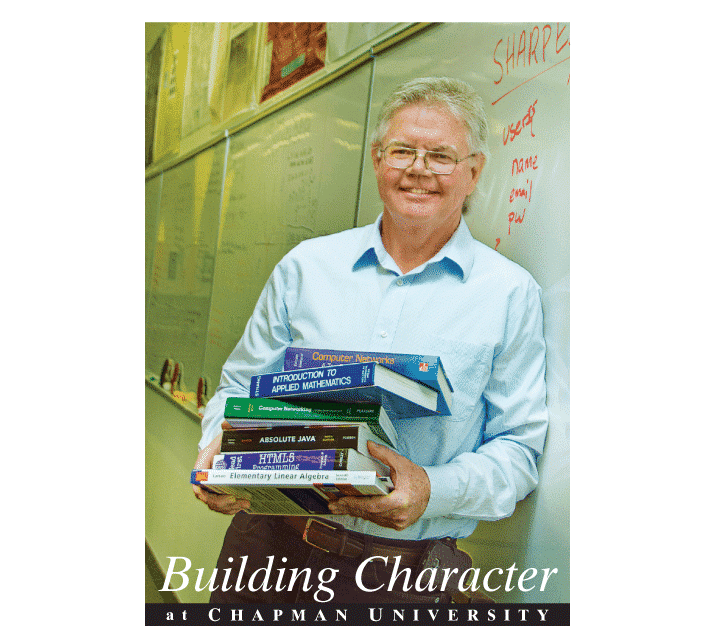[vc_row][vc_column][vc_custom_heading text=”Building Character Dr. Michael Fahy”][vc_single_image image=”326″ img_size=”full”][/vc_column][/vc_row][vc_row][vc_column][vc_column_text]
Dr. Michael Fahy
Back in 1982 when Michael Fahy had some time to himself one weekend, Chapman’s Associate Dean of the School of Computational Sciences had an eureka experience when he bought a computer graphics book at the local bookstore and experimented with the concepts on his home computer.
“I spent the whole weekend writing computer graphics code and watching the results display on the screen,” says Fahy, whose prior experience with computers occurred a decade earlier at UC Santa Barbara when he worked with Fortran, a programming language used for numeric computation and scientific computing that like other programs used punch cards at the time to record data—a process Fahy found uninteresting.
Early Personal Computers
“After the Fortran experience, I didn’t look at computer science for more than a decade until personal computers hit the scene,” says Fahy. “That particular weekend with the computer graphics book, I was so engaged by the process that I didn’t get much sleep. I was completing tasks on the computer that I had previously done with pencil and paper with mathematics, and I really enjoyed being able to see things clearly and accurately as opposed to my hand drawn sketches.”
At the time, Fahy lived in New York City, where he was born and raised. That weekend experience interested him so much that he started a computer software company with his wife, Melodee, which they ran for 15 years in New York and continued with when the couple moved to California in 1989 so Fahy could join Chapman’s faculty.
“We built client networks, connected computers and wrote software to make the networks run. In the beginning, we uploaded software to client sites using modems,” says Fahy, also a professor of mathematics and computer science at Chapman, who has a PhD in mathematics from UC Santa Barbara.
Brandman University’s Network
Fahy’s experience owning a computer company and his mathematics skills prepared him for the various roles he’s played at Chapman over the years. For 10 years from 1996-2006 he served as the university’s Chief Technology Officer, which included developing Brandman University’s area-wide computer network. “Back in the mid-90s, we were discovering the possibilities of what could be done with networking technology, and it was an exciting time,” he says.
“Michael played a huge role in expanding what is now Brandman University” (the university is a separate institution within the Chapman system), says Michael Mahoney, PhD, executive vice president/provost for Trident University International. “Back in the 90s when the general public was just starting to use the internet, he was the person behind connecting all of those external Chapman sites under the Brandman umbrella, which was really impressive, because there was no blueprint for doing so.”
Big Data and Computational Science
When he finished the Brandman network, Fahy moved on to his current project developing Chapman’s new School of Computational Sciences, which has allowed him to combine his interest in math and computer science.
“Computational science has its roots in math and computer science and is used to tackle big data problems in order to answer some of the world’s most complex questions in a wide variety of fields, including science, biology, academics, climate and economics,” says Fahy. “For instance, computational science has been used for purposes such as examining cancer treatments.”
Fahy began developing Chapman’s School of Computational Sciences within the Schmid College of Science & Technology in 2009, using as a guide the first computational science program developed in the country at George Mason University in Virginia, which started its program in the 1990s. Chapman now has a M.S. and PhD. In Computational Science, and Fahy has coordinated partnerships with area businesses so that students can learn from real world experiences.
“Considering that personal credit scores are based on massive amounts of data extracted from people’s purchasing history, we created a partnership with Experian,” says Fahy. “A faculty member spent a period of time at Experian last summer observing in order to gain real world knowledge to develop the curriculum.”
Idea Incubator
The computational sciences department is located in Von Neumann Hall, and the hub of activity is a large warehouse-style room with white boards spanning the walls, as well as a ping pong and pool table and a piano. It is here that students and faculty gather to brainstorm and where the department hosts various events. “The formulas on the white board are serious work, not doodles,” says Fahy. “The space is ideal for creating and collaborating, often among various disciplines, which is the key to discovery.”
Von Neumann Hall is also where they regularly hold fun events for “geeks,” such as the AnyMeeting WebRTC Hackathon held this past January in conjunction with the leading provider of web conferencing, Anymeeting.com. April 4th – 6th the department will host the 44th Interface Symposium on the Interface of Computing Science and Statistics.
http://www.chapman.edu/events/interface-2013/index.aspx
Though Fahy is obviously in his element when it comes to “geeky,” longtime friend Michael Lehman points out that he is surprisingly well-rounded. “Michael is not a nerd,” says Lehman. “People may be surprised to find that he is a talented musician who has played bass in bands, and he rides a motorcycle to work.”
Von Neumann Hall
Named after famed mathematician John von Neumann, who contributed to the fields of computer science, economics, mathematics and physics, Chapman University’s Von Neumann Hall at 545 West Palm is a 1923 industrial-style building in Old Towne. The 6,000 square-foot facility, which was renovated in 2009, is used to house the math department and School of Computational Sciences. Also known as the Western Cordage building, the structure was used for decades to produce rope and cable.
Published in the April 2013 edition of the Old Towne Orange Plaza Review
Written by Julie Bawden-Davis, Photograph by Jeanine Hill
[/vc_column_text][/vc_column][/vc_row]

